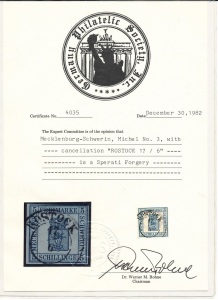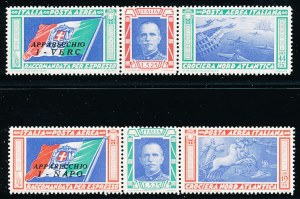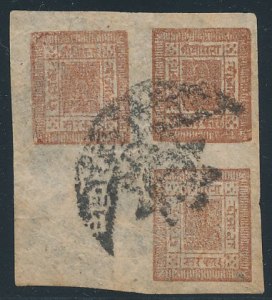While Francois Fournier was a philatelic facsimile maker whose work fools only novices or collectors who have never seen the real thing, Jean de Sperati spent his life creating forgeries designed to undermine the most knowledgeable philatelists. Even his book that he wrote "Philatelie sans Experts" (Philately without Experts) shows his prime motivation was the thrill of creating forgeries that even great experts couldn't tell. And Sperati's work is good, so good, in fact that until about 1920, when it became known that he was doing forgeries, stamps that he made in his workshop would routinely get certificates of genuineness from the most prestigious certifying boards. Sperati's work was a passion. He engraved his stamps from scratch-a process that took months. He bought sheets of genuine stamps so that he could use the selvage for printing his forgeries so that the paper and watermark would be the same as the original. Indeed, one wonders that he bothered at all as the financial gain from
Monthly Archives: January 2020
- Read more »
- Posted January 25, 2020in NewsRead more »
The early days of philately were far more colorful than today. Dealers like J. Walter Scott eagerly waited until the US Local companies were outlawed by congress so that he could buy up the plates from the defunct companies and issue "reprints" to collectors. The rules and protocols that govern our hobby today didn't exist then and most collectors thought as little of genuineness as they did of quality. When heirs call us to tell us that they inherited their great grandfather's collection and that we don't have to worry about the genuineness of the stamps because they were bought so long ago, we respond that if it was their father's collection we would be more sanguine about genuineness but that concerns in this area increase in proportion to how long ago the collection was created.
Francois Fournier perfectly illustrates this change in our hobby. He did not become a stamp dealer until late in li - Posted January 19, 2020in NewsRead more »
Stamps and flight have both had roles in state propaganda machines at various times and never more so than in Italy in the 1930's. Bennito Mussolini came to power in the early 1920's and one of the goals of Italian fascism was to increase the Italian sense of identity as a way of uniting the country. Air travel was new and after Lindbergh crossed the Atlantic in 1927 air travel was as promoted and romanticized as space travel was in the 1960's and 1970's (and no doubt world exploration was in the 1500's). Italo Balbo was a young Italian who knew nothing about airplanes and flying but he knew about propaganda and popularity and more importantly he was politically well connected. He was made the head of the Italian Air Force in 1926 and quickly learned how to fly. His greatest philatelic significance was the 1933 flight that he organized from Rome to Chicago as part of the Century of Progress celebration held in that city (and for which the US #C18 was issued). Flying in an armada of 24 Flying
- Read more »
Nepal is bound in the north by the Himalayan mountains and in the south there is a fertile plain that eases into the Indian heartland. The neighbor to the north, Tibet, is inaccessible because of the more than four mile high mountains so the land to the south, India, has always had great influence on Nepal, supplying immigrants and religious and cultural ideas. It is not surprising, then, that the classic philatelic issues of Nepal have a strong feel of the more primitive Indian Native States' issues. The first stamps of Nepal were issued in 1881 and were really postal issues of the same class as that of the Indian States. Nepal's relations with the outside world were handled by India and the stamps of Nepal were only valid within Nepal and India. Letters from Nepal that went to foreign countries needed Indian postage stamps on them. The printing on these early Nepal issues is very primitive and tete beche pairs are so common as to indicate that the printers who set up the plates from the
- Read more »
In many ways, Ethiopia is a land that time forgot. Always independent, Ethiopia was ruled by a monarchy that traced its origins back to the second century. Because of its strong internal government, Ethiopia was one of the two African countries that was able to resist the European imperialism of the nineteenth century and retain its own government (the other country to retain its independence after the Berlin Conference of 1884 was Liberia). Ethiopia is a remarkable country in many ways. Home to nearly ninety million people, the country has its own calendar (which calculates the years differently than ours so that it is currently 2012 in Addis Ababa, while 365 days are divided into 13 months!) and its own alphabet called Ge'ez. It was one of the first countries to formally adapt Christianity as the official religion, boasts a large Muslim population and is the traditional home of the Falashas-African Jews whose oral history trace their origins to immigrants to Ethiopia after the fall of
- Posted January 08, 2020in NewsRead more »
The political history of South Africa is fascinating. Originally settled by the Dutch in the sixteenth century, South African areas long bounced back and forth under control of the Boers (as the native Dutch decedents were called), the British, who added South Africa to their list of imperial ambitions in the eighteenth century, and native African nations who were displaced by the immigrants and wished for their land back. The Boer Wars of the late nineteenth century were the culmination of decades of strife and the philatelic result was a plethora of philatelic entities. One of the more interesting was Stellaland which issued its own stamps in 1882. It is not clear that anyone recognized Stellaland as an independent country beside the Boer settlers who lived there and who, to bolster their claim as an independent nation, did what dodgy nation states did throughout the nineteenth century- issued postage stamps. The stamps of Stellaland, except for the one penny red and a later surcharged
- Read more »
Anjouan is part of the Comoro Islands group which are a small group of islands between Madagascar and Africa. The islands were long a French dependency and for a brief period around the turn of the last century issued their own postage stamps. The stamps are part of the design called the Peace and Commerce set and they are the same for scores of French Colonies. The Peace and Commerce sets are long definitive sets in which the name of the colony imprinted in a tablet is the only difference between the sets. Anjouani postage stamps served little postal purpose and were largely available from the French philatelic agency in Paris. Anjouan briefly made news a few years ago when there was a small revolution there. The island had briefly declared independence from the Comoros of which it had been a part, and had used its independence to sell the right to incorporate some shady offshore banks. Anjouan is one of those areas that few people have heard of and which even fewer would have heard of
- Posted January 01, 2020in NewsRead more »
Civilization requires communication. As societies have developed, communication has developed with it, both for personal use and for commerce. Throughout the early stamp issuing period many different ways have been tried to speed mail delivery (and remember before electronic communication, the only way to communicate at a distance was by the post). Postal agencies tried airmail. They tried balloons and railroads and trolley cars and even the Pony Express. Speed of communication was always at a premium especially in business where the value of timely information could be immense.
In the late nineteenth century several European countries experimented with pneumatic mail. The system was simple in theory. The tubes work like the tubes they have today at these drive through banking offices. These tubes were laid underground throughout a city and letters could be place in them and routed to their







